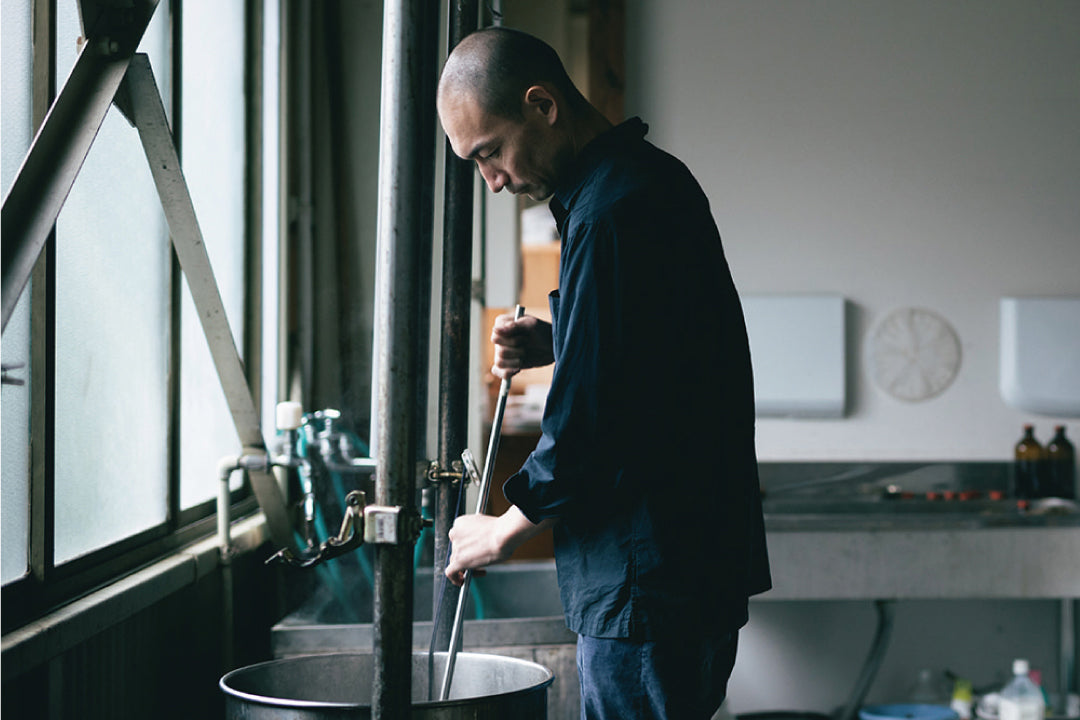
WASHIZU KYOICHIRO
About Kyoichiro Washizu Kyoichiro Washizu, the fifth generation owner of Washizu Dyeing Shop in Shizuoka, creates works using the traditional Suruga Japanese dyeing technique of "tea dyeing." He has begun researching tea dyeing using parts discarded in the manufacturing process of tea, Shizuoka's core industry, and is unique in his upcycling efforts, such as processing tea leaves after boiling them into compost and recycling them.
"In Shizuoka, stencil dyeing and hand-drawn crest dyeing techniques have been passed down since ancient times, and my parents' house runs a dyeing shop. Tea is also one of Shizuoka's leading industries, and I wanted to nurture and preserve both of these cultures. I learned dyeing techniques from my father, and one day, a senior tea farmer gave me some tea leaves that were being discarded at a processing plant. Although you can't drink it, I wondered if I could fix the color of the tea to fabric like plant dyeing, and that's how I researched tea dyeing. After about two years of trial and error, I finally achieved the ideal color and dye intensity. Re-dying yellowed T-shirts and dyeing curtains not only extends their useful life, but also makes the fabric stronger and improves its texture. The leftovers from the dyeing process can be used as fertilizer for the fields, and I want to spread sustainable efforts using local industries."

About "Mariko-shuku" of the Fifty-three Stations of the Tokaido The "Sunpu Workshop Takumi-shuku" where Washizu has his workshop is located in the Maruko Izumigatani district, also known as a post town. Renovated in 2021 as one of Japan's largest traditional craft experience facilities, it is a complex facility with a cafe, shop, and gallery. In addition, professional artists active on the front lines serve as workshop managers in the four workshops, where you can experience a variety of crafts such as Suruga bamboo senjiki crafts, Japanese dyeing, woodworking, lacquer, and pottery. As the workshop manager, Washizu is in charge of tea dyeing workshops, and his works can be seen throughout the building.

Washizu is also active as a tea dye artist. He boils tea to dye the cloth, then mixes in iron wood acetate and boils it again. After drying, he boils the cloth in tea again to dye it a deep brown. The cloth is then cut into shapes using a titanium mordant, resulting in a tasteful pattern. The concept is "aerial view of the tea field," and it features a geometric pattern looking down on the tea field from above. "I wanted to express the view of the tea field as seen from above, so although it is stencil dyed, I slightly wavered the outline to make it closer to the natural landscape," he says of his work, which is captivating with its powerful patterns. The huge piece he worked on in a team with his disciple Maeda Yuki was selected for the Kokuten exhibition, Japan's largest open exhibition run by the Kokugakai, in 2023 and 2024.

From Kyoichiro Washizu At first, I wanted to pursue my own technique by fusing local traditional industry with crafts. However, the value of tea dyeing will not be recognized unless it is popularized as a culture. So I started making works that combined stencil dyeing, which I learned from my father, with tea dyeing, and now I hope that the culture of re-dyeing old fabrics and the technique of tea dyeing will become a platform for people to interact with each other. In order to spread this, we will increase our own value as artists. First of all, I would like people to experience the charm of tea dyeing, and eventually I would be happy if the tea industry and tea dyeing culture spread together. I will inherit the traditions and techniques that my predecessors created and accumulated, and move forward even a little while making my own ingenuity. In this way, we will nurture the culture and pass it on to the next generation, and it will become a new tradition. I would like to work hard to be a part of that. / Washizu







